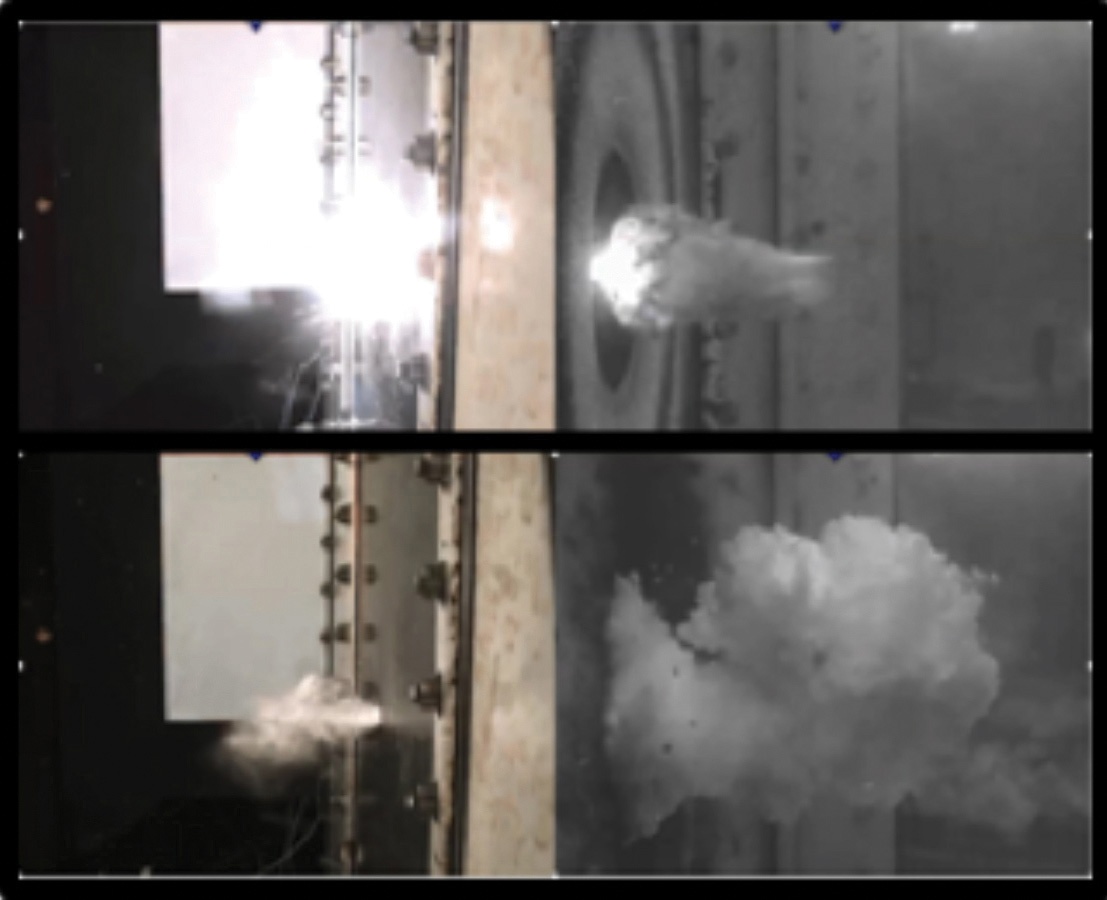
Stay Up to Date
Submit your email address to receive the latest industry and Aerospace America news.

The Survivability Technical Committee promotes air and spacecraft survivability as a design discipline that includes such factors as crashworthiness, combat and repairability.
For characterization of aircraft vulnerability to steel fragments’ impact on aircraft aluminum structure, the resulting entry and exit flash strengths and flash durations need to be measured. The U.S. Air Force from January to July conducted impact tests at Wright-Patterson Air Force Base in Ohio to acquire impact flash data. This data will aid in developing and validating models to predict the duration of front-face and back-face flash from steel fragments impacting aluminum target plate arrays. The data also will help in developing algorithms to predict the duration of front-face and back-face flash from steel fragments. The tests were performed using high-speed cameras and experimental laser imaging capture techniques from the Air Force Institute of Technology. The project is being executed within the structure of an integrated product team in support of the Next Generation Fire Model. The objective of the project is to generate data, perform shock physics on modeling and simulation, and develop and implement algorithms for fragment flash for accurate predictions of aircraft vulnerability to fragment threats.
The Air Force this year continued its HRAM, for Hydrodynamic Ram, Spurt Model Development and Validation program for fuel tank vulnerability from penetrating munitions by performing Phase 2 planning in April, followed by testing in August and September, building on its effort and data obtained in fiscal 2017 of Phase 1. The objective of the program is to develop an understanding of the fundamental physics associated with ballistically induced, hydrodynamic fuel spurts through physics-based modeling, supported with test data and statistical analyses. The program will ultimately lead to a fast running tool for predicting spurt timing within fuel tank vulnerability assessments. This Phase 2 HRAM testing is using a large fuel tank and pressure transducers designed to be submerged in fluids. A parallel approach is underway using physics-based analysis techniques and test data.
The Air Force continued its fuel tank ullage vapor ignition vulnerability study this year by performing a test series to characterize the vulnerability to simulated fragment induced fuel tank ullage ignition. Ullage conditions and fuel temperatures were based on flight scenarios, altitudes and combat sortie simulations. The test series evaluated ullage ignition characteristics within a simulated fuel tank utilizing various fuel conditions, igniter locations, fuel heights/levels, geometric conditions via three tanks, and several internal pressures. Three fuel tank sizes, including 2,100 liter and 3,790 liter capacity (1,000 and 550 gallons), were tested during January to July and filled with Jet A fuel. To simulate a threat encounter at high altitudes, the fixtures were tested under low vacuum conditions, which was the first ever test series within the survivability community. Tests were able to be conducted under pressure conditions down to 20.7 kilopascal (3 pounds per square inch absolute) from an atmospheric pressure of 98.6 kilopascal (14.3 PSIA). The test series also investigated a sequence of vented ullage ignition tests conducted within the fuel tank simulator. Over 300 tests have been conducted to date. Data are being used for aircraft fuel tank design and are being transitioned into the Next Generation Fire Prediction Model.
On the civilian aviation side, the engine fan blade containment accident in April on a Southwest Airline flight exemplified the sound design intent for containment but also the inability to prevent additional separated parts from damaging the fuselage. The GE-Safran engine has 24 metallic (titanium) blades one of which separated at the root, due to metal fatigue. Blade separation is rare, occurring about three to four times a year worldwide. The Southwest blade, though contained, caused impact damage to the inlet and fan cowls, causing large pieces to separate and cause damage to the wing and fuselage. One piece hit and shattered a passenger window causing a fatal injury. The plane landed safely in Philadelphia with one engine. This is an example of aircraft design for survivability (landing with one engine), but reflects still-needed efforts in preventing engine secondary parts from separation due to blade impact.
In the U.S. Air Force photo at top: A high-speed camera photographed a hydrodynamic ram event, HRAM, this year to assess the vulnerability of fuel tanks to penetrating threats. The impact occurs from left to right. The resulting bubble inside the tank can be seen on the right side. The resulting fluid spurt goes out of the impact hole on the left. The research was conducted at Wright-Patterson Air Force Base, Ohio.
Stay Up to Date
Submit your email address to receive the latest industry and Aerospace America news.



